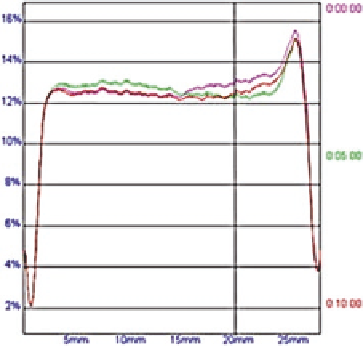Biomedical Engineering Reference
In-Depth Information
Fig. 5.2
Backscattering
profiles of solid lipid
nanoparticles prepared by
ultrasonication technique.
Reprinted from Colloid
Surface B Silva et al. (
2011
),
with permission from
Elsevier
The principle of Turbiscan® is based on analysis of multiple scattering of light
by concentrated dispersions. Turbiscan® is equipped with a near-infrared mono-
chromatic light source (
λ
=
880 nm) and two synchronous backscattering (BS)
and transmission (T) detectors. Turbiscan® measures the BS and T signals arising
from backscattering and crossing of samples, respectively. These signals denote
the fluctuations on particle volume and size which represent particle migration
(creaming, sedimentation) and particle aggregation (coalescence, flocculation),
respectively. Particle migration is reversible wherein the particles can be easily
redispersed by mechanical stirring, and particle aggregation is often irreversible
(Silva et al.
2011
). Figure
5.2
shows an illustrative backscattering profile of SLNs.
It shows BS signals arising from backscattering of samples. Deviation within
±
2 % is often taken as an indicator of stable formulation.
5.4.2 Chemical Stability
The biological performance of lipid nanoparticle dispersions is highly dependent on
the chemical stability of the incorporated drug molecules. Measurement of chemi-
cal stability is essential to calculate the encapsulation efficiency and drug loading of
the lipid nanoparticle system. The degradation products of drugs may be potentially
toxic, and therefore, it is necessary to investigate the chemical stability of drugs.
Chemical stability of lipid nanoparticles can usually be measured by two differ-
ent approaches—destructive and non-destructive. Destructive methods rely upon
dissolution of carrier system in organic solvents to release the drug. Quantification
of the drug is usually performed by spectroscopic or chromatographic methods
(Jia et al.
2012
; Liu et al.
2011
; Nik et al.
2012
; Tsai et al.
2012
).
Although these assays are simple, the quantified drug is inclusive of both
encapsulated and unencapsulated drug molecules. Organic solvents such as metha-
nol, acetone, acetonitrile or tetrahydrofuran that may be used for destruction of

Search WWH ::

Custom Search